第六节 数词与主谓一致
- 格式:doc
- 大小:54.50 KB
- 文档页数:4
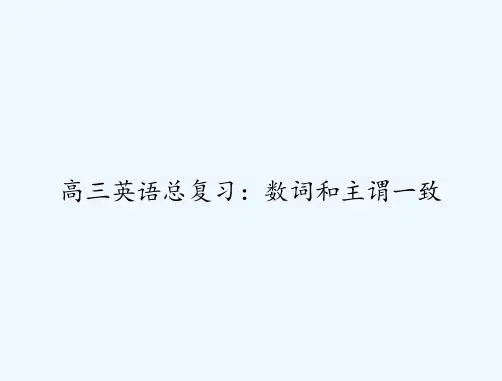
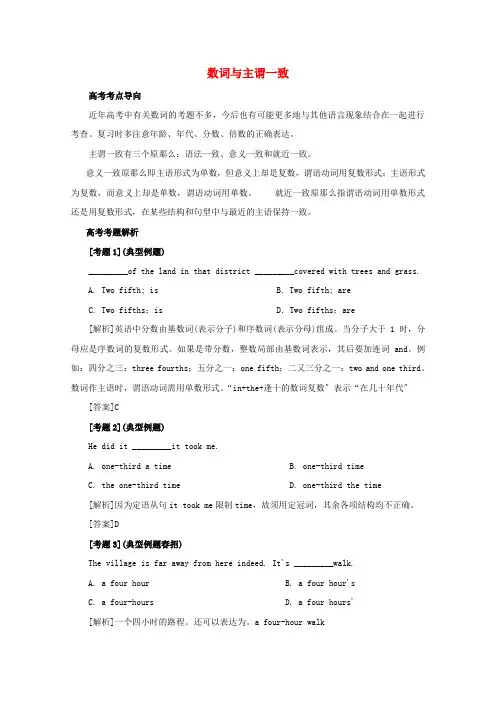
数词与主谓一致高考考点导向近年高考中有关数词的考题不多,今后也有可能更多地与其他语言现象结合在一起进行考查。
复习时多注意年龄、年代、分数、倍数的正确表达。
主谓一致有三个原那么:语法一致、意义一致和就近一致。
意义一致原那么即主语形式为单数,但意义上却是复数,谓语动词用复数形式;主语形式为复数,而意义上却是单数,谓语动词用单数。
就近一致原那么指谓语动词用单数形式还是用复数形式,在某些结构和句型中与最近的主语保持一致。
高考考题解析[考题1](典型例题)_________of the land in that district _________covered with trees and grass.A. Two fifth; isB. Two fifth; areC. Two fifths;is D.Two fifths;are[解析]英语中分数由基数词(表示分子)和序数词(表示分母)组成。
当分子大于1时,分母应是序数词的复数形式。
如果是带分数,整数局部由基数词表示,其后要加连词 and。
例如:四分之三:three fourths;五分之一:one fifth;二又三分之一:two and one third。
数词作主语时,谓语动词需用单数形式。
“in+the+逢十的数词复数〞表示“在几十年代〞[答案]C[考题2](典型例题)He did it _________it took me.A. one-third a timeB. one-third timeC. the one-third timeD. one-third the time[解析]因为定语从句it took me限制time,故须用定冠词,其余各项结构均不正确。
[答案]D[考题3](典型例题春招)The village is far away from here indeed. It's _________walk.A. a four hourB. a four hour'sC. a four-hoursD. a four hours'[解析]一个四小时的路程。


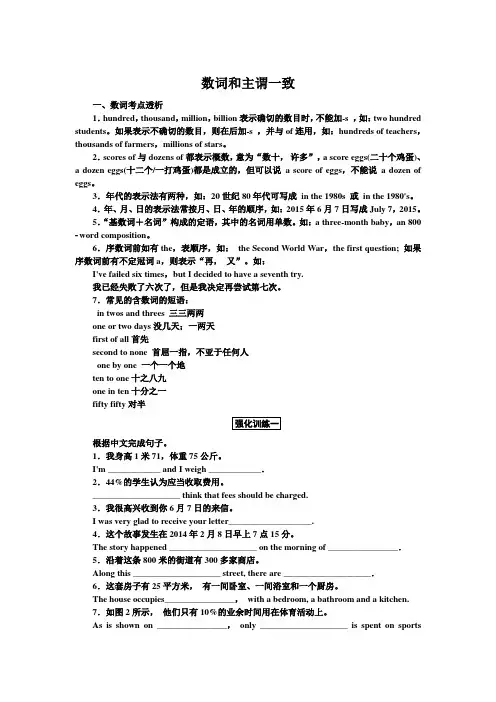
数词和主谓一致一、数词考点透析1.hundred,thousand,million,billion表示确切的数目时,不能加-s ,如:two hundred students。
如果表示不确切的数目,则在后加-s ,并与of连用,如:hundreds of teachers,thousands of farmers,millions of stars。
2.scores of与dozens of都表示概数,意为“数十,许多”,a score eggs(二十个鸡蛋)、a dozen eggs(十二个/一打鸡蛋)都是成立的,但可以说a score of eggs,不能说a dozen of eggs。
3.年代的表示法有两种,如:20世纪80年代可写成in the 1980s 或in the 1980's。
4.年、月、日的表示法常按月、日、年的顺序,如:2015年6月7日写成July 7,2015。
5.“基数词+名词”构成的定语,其中的名词用单数。
如:a three-month baby,an 800word composition。
6.序数词前如有the,表顺序,如:the Second World War,the first question; 如果序数词前有不定冠词a,则表示“再,又”。
如:I've failed six times,but I decided to have a seventh try.我已经失败了六次了,但是我决定再尝试第七次。
7.常见的含数词的短语:in twos and threes 三三两两one or two days没几天;一两天first of all首先second to none 首屈一指,不亚于任何人one by one 一个一个地ten to one十之八九one in ten十分之一fifty fifty对半强化训练一根据中文完成句子。
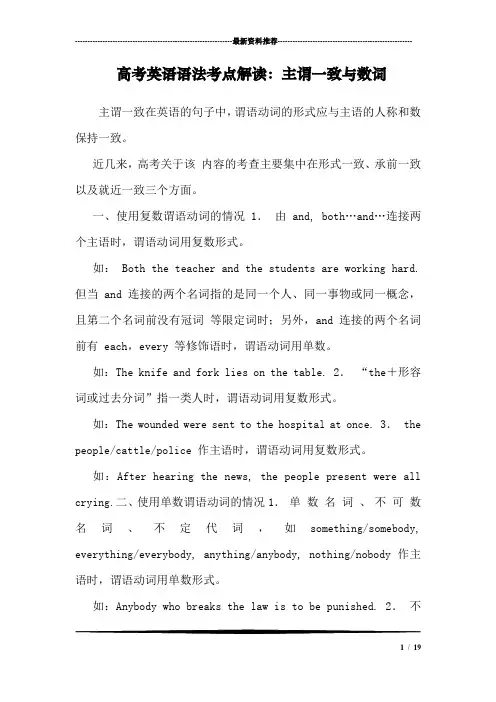
---------------------------------------------------------------最新资料推荐------------------------------------------------------ 高考英语语法考点解读:主谓一致与数词主谓一致在英语的句子中,谓语动词的形式应与主语的人称和数保持一致。
近几来,高考关于该内容的考查主要集中在形式一致、承前一致以及就近一致三个方面。
一、使用复数谓语动词的情况1.由and, both…and…连接两个主语时,谓语动词用复数形式。
如: Both the teacher and the students are working hard.但当 and 连接的两个名词指的是同一个人、同一事物或同一概念,且第二个名词前没有冠词等限定词时;另外,and 连接的两个名词前有 each,every 等修饰语时,谓语动词用单数。
如:The knife and fork lies on the table. 2.“the+形容词或过去分词”指一类人时,谓语动词用复数形式。
如:The wounded were sent to the hospital at once. 3. the people/cattle/police 作主语时,谓语动词用复数形式。
如:After hearing the news, the people present were all crying.二、使用单数谓语动词的情况1.单数名词、不可数名词、不定代词,如something/somebody, everything/everybody, anything/anybody, nothing/nobody 作主语时,谓语动词用单数形式。
如:Anybody who breaks the law is to be punished. 2.不1/ 19定式、动名词、主语从句作主语,谓语动词用单数形式。

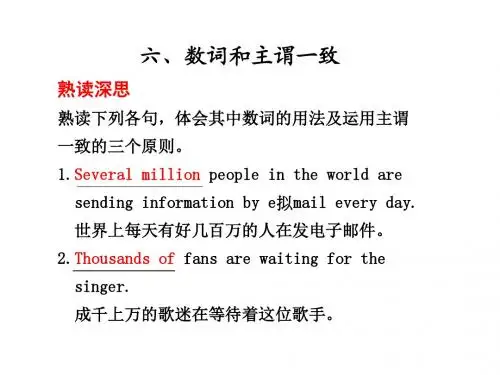
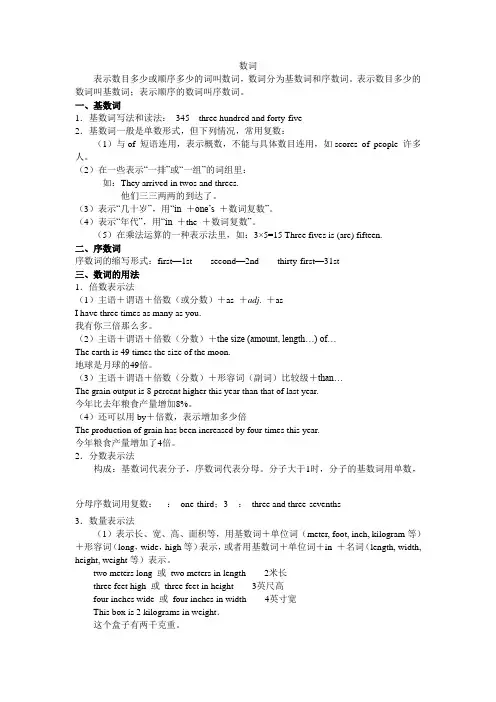
数词表示数目多少或顺序多少的词叫数词,数词分为基数词和序数词。
表示数目多少的数词叫基数词;表示顺序的数词叫序数词。
一、基数词1.基数词写法和读法:345three hundred and forty-five2.基数词一般是单数形式,但下列情况,常用复数:(1)与of 短语连用,表示概数,不能与具体数目连用,如scores of people 许多人。
(2)在一些表示“一排”或“一组”的词组里:如:They arrived in twos and threes.他们三三两两的到达了。
(3)表示“几十岁”,用“in +one’s +数词复数”。
(4)表示“年代”,用“in +the +数词复数”。
(5)在乘法运算的一种表示法里,如:3×5=15 Three fives is (are) fifteen.二、序数词序数词的缩写形式:first—1st second—2nd thirty-first—31st三、数词的用法1.倍数表示法(1)主语+谓语+倍数(或分数)+as +adj. +asI have three times as many as you.我有你三倍那么多。
(2)主语+谓语+倍数(分数)+the size (amount, length…) of…The earth is 49 times the size of the moon.地球是月球的49倍。
(3)主语+谓语+倍数(分数)+形容词(副词)比较级+than…The grain output is 8 percent higher this year than that of last year.今年比去年粮食产量增加8%。
(4)还可以用by+倍数,表示增加多少倍The production of grain has been increased by four times this year.今年粮食产量增加了4倍。
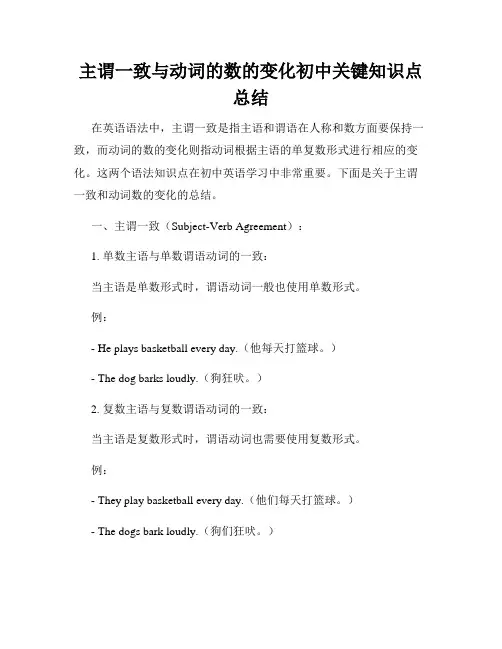
主谓一致与动词的数的变化初中关键知识点总结在英语语法中,主谓一致是指主语和谓语在人称和数方面要保持一致,而动词的数的变化则指动词根据主语的单复数形式进行相应的变化。
这两个语法知识点在初中英语学习中非常重要。
下面是关于主谓一致和动词数的变化的总结。
一、主谓一致(Subject-Verb Agreement):1. 单数主语与单数谓语动词的一致:当主语是单数形式时,谓语动词一般也使用单数形式。
例:- He plays basketball every day.(他每天打篮球。
)- The dog barks loudly.(狗狂吠。
)2. 复数主语与复数谓语动词的一致:当主语是复数形式时,谓语动词也需要使用复数形式。
例:- They play basketball every day.(他们每天打篮球。
)- The dogs bark loudly.(狗们狂吠。
)3. 以“every”、“each”、“either”、“neither”开头的主语与单数谓语动词的一致:无论主语是否为单数形式,以“every”、“each”、“either”、“neither”开头的句子,谓语动词都需要使用单数形式。
例:- Every student has a textbook.(每个学生都有一本教科书。
)- Either he or his friends is coming to the party.(他或者他的朋友们中的一个会来参加聚会。
)4. 不可数名词作主语与单数谓语动词的一致:不可数名词作主语时,谓语动词一般使用单数形式。
例:- Water is important for our health.(水对我们的健康很重要。
)- The music sounds beautiful.(音乐听起来很美。
)二、动词的数的变化(Subject-Verb Agreement):1. 一般情况下,动词+s/es的形式:当主语是第三人称单数时,动词加上-s或-es的形式。
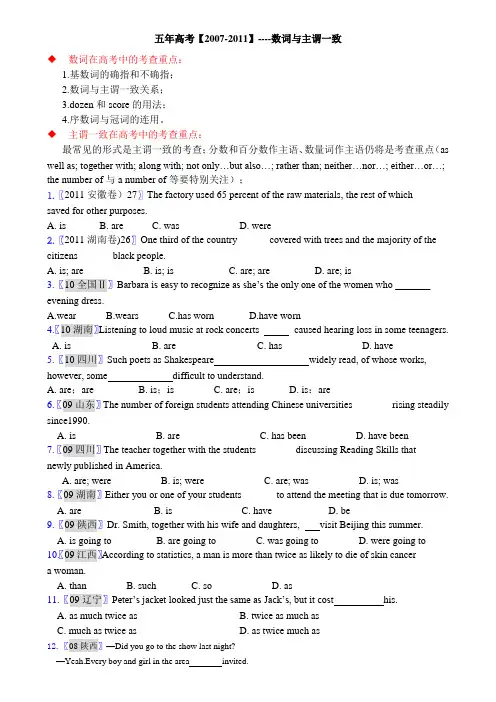
第六节数词与主谓⼀致第六节数词与主谓⼀致⼀.数词数词(num.)分为基数词,序数词,分数,⼩数和概数巧计基数词变序数词:基变序,有规律;⼀⼆三,单独记;⼋去t,九去e, ve要⽤f替;整⼗基数变序数,ty变为tie;要是遇到两位数,⼗位基数个位序。
2. 分数分数是由基数词和序数词组成的,分⼦⽤基数词,分母⽤序数词,当基数词⼤于1时,序数词要⽤复数形式。
one fifth three fourths3.⼩数⼩数点读作point8.9-eight point nine 0.3- zero point three4.概数(1)概数的表⽰tens of/ hundreds of/ thousands of/ millions of/ dozens of/ scores of/ a number of/ a quantity of/ a few of/ a little of/ plenty of 等。
(2)概数的注意事项概数前不能有确切的数字,可以⽤many, several, some等修饰tens of/ hundreds of/ thousands of/ millions of/ dozens of/ scores of。
只修饰可数名词复数形式的有:tens of/ hundreds of/ thousands of/ millions of/ dozens of/ scores of/ a number of/ a few / a great of只修饰不可数名词的有:a little/ a great deal of既可修饰可数名词也可修饰不可数名词的有:a quantity of/ quantities of/ a lot of/ lots of/ plenty of5. 关于数的其他表达法(1)年代的表达法为in+the+“逢⼗的数词复数”在20世纪90年代-------- in the 1990s或in the 1990’s(2)“在某⼈⼏⼗来岁时”的表达法为in+one’s+“逢⼗的基数词复数”在他50多岁时------------in his fifties⼆. 主谓⼀致1. 语法形式上的⼀致主语为单数形式,谓语动词⽤单数形式;主语为复数形式,谓语动词⽤复数形式Jane and Mary look alike.2. 意义上的⼀致,即概念⼀致原则(1)主语形式为单数,但是意义上却是复数,谓语动词⽤复数The crowd were running for their lives.(2) 主语形式为复数,但意义上是单数,谓语动词⽤单数The news was very exciting.3. 就近⼀致原则主要的连词为or, either…or, neither…nor, not only…but also和there be句型4. 应注意的⼏个问题(1)某些集体名词,如:family, team等,做主语时,如果作为⼀个整体来看待,谓语动词⽤单数;如果侧重强调集体⾥⾯的每个成员,谓语动词⽤复数形式。
数词与主谓一致一、数词分为基数词、序数词、分数、小数和概数。
复习时要注意下面问题:1.基数词的意义:表示事物数量的多少,特别是hundred,thousand,million等,前面若有基数词或某些表示数量的形容词时,它们只能用单数;2.序数词的意义:表示事物的顺序,前面一般要加定冠词;3.分数的形式:分子用基数词,分母用序数词,当基数词大于“1”时,序数词后要用复数形式;4.小数的组成和读法:小数点读作point,小数点前面的数按基数词的方法读,小数点后面的数按数字读;5.概数(1)概数的表示:tens of/hundreds of/thousands of/millions of/dozens of/scores of/a number of/a quantity of/a few/a little/a great deal of/a great(good)many(2)概数的注意事项:概数前面不能有确切的数字,但tens of/hundreds of/thousands of/millions of/dozens of/scores of前面可有many,several,some等修饰词:tens of/hundreds of/thousands of /millions of/dozens of/sc0Iles of/a number of/a few/a great(good)many一般只修饰可数名词复数;a little/a great deal of只修饰不可数名词;a quantity of/a lot of/lots of/plenty of既可修饰可数名词复数,又可修饰不可数名词;few/little形式上是肯定,而意义上是否定;a few/a little才表示肯定的意义。
6.倍数的表示:(1)倍数(twice,…times)+as+形容词原级+as...(2)倍数+形容词的比较级+than...(3)倍数+the+ n.(size/length/height/width/weight)+of二.主谓一致、1.主谓一致的原则:形式一致;内容一致;就近一致。
数词与量词作主语时的主谓一致情况1. 表示时间、重量、距离、价格、体积等名词的复数作主语时,通常当整体看,谓语用单数形式。
Twenty years is a long time in one’s life. 20年在人的一生中是很长的一段时间。
Forty miles was covered in a single night. 一夜走了40英里。
20,000 dollars is not a small sum of money. 两万美元不是一笔小数目的钱。
2. 分数和百分数修饰可数或不可数名词作主语时,谓语的形式取决于它们表示的意义。
About one third of the books are worth reading. 这些书中大约有1/3值得读一读。
A large percentage of the wheat crop was ruined by the flood. 大部分的麦类作物被洪水毁掉了。
Only 60 percent of the work was done yesterday. 昨天只干了60%的工作。
About 20 percent of the students are absent today. 今天有大约20%的学生缺席。
3. 由“kind (form, type, sort, species, portion, series) of”等修饰的主语,其谓语形式取决于这些词的单复数而不是它们后面所跟的名词。
如:This new type of buses is now on show. (但Buses of this kind are now on show.)现在正展出一种新型的公共汽车。
All kinds of difficulties have to be overcome. 必须克服各种各样的困难。
Some new forms of art were discussed at the meeting. 会上讨论了一些新的艺术形式。
高考冲刺复习:数词主谓一致学大教育一对一 . 英语辅导讲义数词一.基数词用法要点考点:1. hundred, thousand, million, billion, dozen, score 与具体的数词连用表示具体数目时,习惯上用单数,而且也不后接介词of。
如:注:当这些词后面的名词有了the, these, those等特指限定词修饰时,或其后的接的是us, them 这样的人称代词时,则此时必须用介词 of。
如:two dozen of these pens, three score of them, 2. 当以上词不与具体数字连用,而是后接of表示概数时,用复数。
如:hundreds of students, dozens of eggs(几十个鸡蛋),scores of pencils(几十根铅笔) The sun was shining. Thousands of people were lying on the beach. 阳光灿烂,数以千计的人躺在海滩上。
二.序数词用法要点考点序数词在句中可作主语、表语、宾语、同位语和状语等。
1.序数词表示顺序,是第几的意思,如:first(第一), second(第二), third(第三), fifth(第五), twelfth(第十二), twentieth(第二十)等。
2.序数词作主语,前面一般有定冠词。
The first is better than the second.第一个比第二个好。
3.序数词作宾语,前面一般有定冠词。
I like the second on the left.左边第二个。
He was among the first to arrive. 他是第一批到达的人。
(the first作介词among的宾语。
)4.序数词用作副词修饰动词时不加冠词。
When did you first meet him? 你第一次见到他是什么时候?5.序数词作同位语,前面须有定冠词。
第六节数词与主谓一致一.数词数词(num.)分为基数词,序数词,分数,小数和概数巧计基数词变序数词:基变序,有规律;一二三,单独记;八去t,九去e, ve要用f替;整十基数变序数,ty变为tie;要是遇到两位数,十位基数个位序。
2. 分数分数是由基数词和序数词组成的,分子用基数词,分母用序数词,当基数词大于1时,序数词要用复数形式。
one fifth three fourths3.小数小数点读作point8.9-eight point nine 0.3- zero point three4.概数(1)概数的表示tens of/ hundreds of/ thousands of/ millions of/ dozens of/ scores of/ a number of/ a quantity of/ a few of/ a little of/ plenty of等。
(2)概数的注意事项概数前不能有确切的数字,可以用many, several, some等修饰tens of/ hundreds of/ thousands of/ millions of/ dozens of/ scores of。
只修饰可数名词复数形式的有:tens of/ hundreds of/ thousands of/ millions of/ dozens of/ scores of/ a number of/ a few / a great of只修饰不可数名词的有:a little/ a great deal of既可修饰可数名词也可修饰不可数名词的有:a quantity of/ quantities of/ a lot of/ lots of/ plenty of5. 关于数的其他表达法(1)年代的表达法为in+the+“逢十的数词复数”在20世纪90年代-------- in the 1990s或in the 1990’s(2)“在某人几十来岁时”的表达法为in+one’s+“逢十的基数词复数”在他50多岁时------------in his fifties二. 主谓一致1. 语法形式上的一致主语为单数形式,谓语动词用单数形式;主语为复数形式,谓语动词用复数形式Jane and Mary look alike.2. 意义上的一致,即概念一致原则(1)主语形式为单数,但是意义上却是复数,谓语动词用复数The crowd were running for their lives.(2) 主语形式为复数,但意义上是单数,谓语动词用单数The news was very exciting.3. 就近一致原则主要的连词为or, either…or, neither…nor, not only…but also和there be句型4. 应注意的几个问题(1)某些集体名词,如:family, team等,做主语时,如果作为一个整体来看待,谓语动词用单数;如果侧重强调集体里面的每个成员,谓语动词用复数形式。
His family is big. The whole family are watching TV.这类名词有:class, club, company, crowd, enemy, group, team, crew, government, audience等(2)某些集体名词,如people, police, cattle等,只能当做复数看待,其谓语必须用复数。
(3)单复数同形的名词作主语时,按意义一致的原则。
用作单数意义时,谓语动词用单数;用作复数意义时,谓语动词用复数。
这类名词有:works工厂, Chinese,Japanese, means, species, sheep等。
The glass works was set up in 2001.These glass works are near the city.(4)由and 或both…and连接并列主语,谓语通常用复数形式。
(5)当主语后面跟有like, with, along with, together with, but, except, besides, as well as, rather than等引导词组时,其谓语动词的单复数按照主语的单复数而定。
(6)如果主语由more than one…或many a…构成,尽管从意义上是复数内容,但其谓语动词任用单数形式。
More than one person has visited the park. Many a student has finished the task.(7)一些由两个部分构成的表示衣物或工具的名词作主语时,谓语通常用复数形式,如:glasses眼镜,clothes, trousers, shoes, scissors剪刀, chopsticks筷子等,但如果主语是“a kind of, a pair of 等+以上名词”,谓语动词一般用单数形式。
My shoes are very dirty. A pair of shoes was on the floor.(8)this kind of book= a book of this kind做主语时,谓语用单数;短语this kind of men, this kind of books作主语时,谓语用单数,但men of this kind, these kinds of men 做主语时,谓语用复数。
This kind of men is dangerous. Men of this kind are dangerous.(9)either/ neither/ none单独做主语或either/neither/none of+名词复数作主语时,谓语一般用单数,有时也可用复数。
Neither of us has/have ever been to England.(10) one and a half 后的名词要用复数形式,但是该名词作主语时,谓语动词仍用单数形式。
One and a half apples is left on the table.衔接训练一.单项选择1.______ trees have been planted in our school in the past 10 years.A. Thousands ofB. Two thousandsC. Thousand ofD. Two thousands of2._______ of the world’s books and newspapers are written in English.A. Three quartersB. Three quarterC. Thirds fourD. Three fourth3. He asked _________ question before I could answer _______ one.A. a second, the firstB. a second, a firstC. the second, firstD. second, first4. When she was in _________, she got married. She had a good time after that.A. her twentiethB. her twentiesC. the twentiesD. the twentieth5. Flight 19 from New York to Washington is now arriving at __________.A. Gate TwoB. the gate twoC. the two gateD. second gate6.Two fifths of the population in this area _______ farmers. They have much difficulty in the economic transformationA. isB. areC. wasD. has been7. Nobody but the twins __________ some interest in the project since 2000.A. showsB. showC. have shownD. has shown8. So far, almost ________ of the people in this city ________ victims of the great accident. They help each other to get through the hard time.A. four fifths, has becomeB. four fifths, have becomeC. four fifths, has becomeD. four fifth, have become9.–Do you know when the American Civil War broke out?--Sorry, I don’t know when exactly. I just know it broke out in ________.A. the year of 1860sB. early 1860sC. its early 1860’sD. the early 1860’s10.– Is either he or I fit for the job?-Neither he nor you ________. I am looking for a better one.A. isB. wasC. areD. were11. The whole family _________ TV whenever I go to their place. I have no chance to chalk with them.A. are watchingB. were watchingC. is seeingD. was watching12. The battle was over, and the wounded _______ sent to hospital and the dead ____ buried.A. was, wasB. were, wereC. is, isD. are, are13. A library with five thousands books _________ to the nation as a gift. This had an effect on children.A. was offeredB. has offeredC. were offeredD. have offered14.–What about the books? -Books of this kind _________ well.A. sellB.sellsC. was soldD.is sold15. Bob together with John and Mike _________ to the museum in the morning.A. are goingB. have goneC. has goneD. were going16. Every means __________ tried to save the poor girl, but in vain.A. have beenB. hadC. has beenD. are二. 用括号里所给的词的适当形式填空Coffee ______ (have) been a part of people’s lives for thousands of years, and today it _____ (be) still a favorite drink of millions of people in the world. Coffee _______ (be) so popular, but do you know the story of coffee and how it _____ (be) discovered?There ______ (be) an old story that ________ (say) coffee _____ (be) discovered in African a long, long time ago. One day, a farmer ________ (be) watching his goats, and he saw them eat some small berries from a plant. After they ate the berries, the goats became very active. The man often felt tired, so he decided to try the berries, too. Surprisingly, he didn’t feel tired any more. Coffee plants ________ (be) thus discovered. Then coffee _______ (be) taken from African to Arabia, and there it ______ (be) first used as medicine. The Arabs kept coffee a secret for many years. Later, coffee plant _______ (be) taken to America. People found that coffee plant grew well in many parts of South America, so large coffee farms ______ (be) stared, and many coffee plants ________ (be) grown. on these farms, coffee beans ________ (be) picked from the plant by hand. Then the beans _______ (be) dried and prepared for market to sell.。